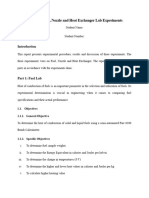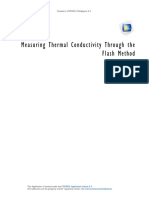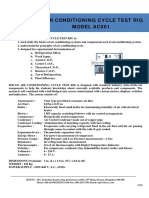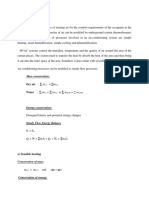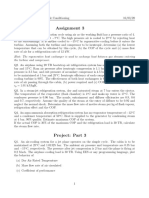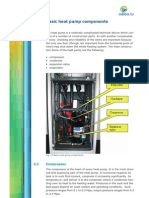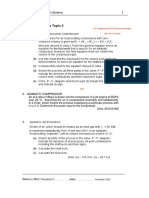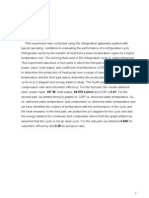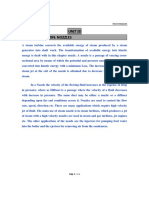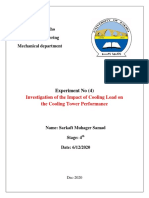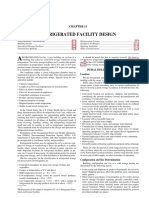TutorialX RefrigerationCycle
TutorialX RefrigerationCycle
Uploaded by
Anurag KumarCopyright:
Available Formats
TutorialX RefrigerationCycle
TutorialX RefrigerationCycle
Uploaded by
Anurag KumarOriginal Description:
Original Title
Copyright
Available Formats
Share this document
Did you find this document useful?
Is this content inappropriate?
Copyright:
Available Formats
TutorialX RefrigerationCycle
TutorialX RefrigerationCycle
Uploaded by
Anurag KumarCopyright:
Available Formats
Tutorial – X
MIN 106: Thermodynamics
Department of Mechanical and Industrial Engineering, IIT Roorkee
Topic: Vapor refrigeration cycle
1) Refrigerant-134a is the working fluid in an ideal compression refrigeration cycle. The
refrigerant leaves the evaporator at -20oC and has a condenser pressure of 0.9 MPa. The
mass flow rate is 3 kg/min. Find rate of heat removal, COPR and COPR, Carnot for the same
Tmax and Tmin. [6.84 kW, 3.44, 3.97]
2) A refrigerator uses refrigerant-134a as the working fluid and operates on an ideal vapor-
compression cycle between 0.14 and 0.8 MPa. The mass flow rate of refrigerant is 0.06 kg/s.
Determine (a) the rate of heat removal from the refrigerated space and the power input to
compressor, (b) the power input to compressor (c) the rate of heat rejection to the
environment and (d) the coefficient of performance. [8.56kW, 2.16 kW, (b) 10.72 kW, (c)
3.963]
3) A refrigerator uses refrigerant-134a as the working fluid and operates on an ideal vapor-
compression cycle between 0.12 and 0.7 MPa. The mass flow rate of refrigerant is 0.05 kg/s.
Show the cycle on a T-s diagram. Determine (a) the rate of heat removal from the
refrigerated space and the power input to compressor, (b) the rate of heat rejection to the
environment and (c) the coefficient of performance. [(a)7.41 kW, 1.83 kW, (b) 9.23 kW, (c)
4.06]
4) Refrigerant-134a enters the compressor of a refrigerator at 140 kPa and -10oC at a rate of 0.3
m3/min and leaves at 1 MPs. The isentropic efficiency of the compressor is 78 percent. The
refrigerant enters the throttling valve at 0.95 MPa and 30oC and leaves the evaporator as
saturated vapor at -18.5oC. Show the cycle on a T-s diagram and determine (a) the power
input to the compressor, (b) the rate of heat removal from the refrigerated space, and (c) the
pressure drop and rate of heat gain in the line between the evaporator and the compressor.
[(a)1.88 kW, (b) 4.99 kW, (c) 1.65 kPa, 0.241 kW]
5) A refrigerator operates on the ideal vapor-compression refrigeration cycle with refrigerant-
134a as the working fluid. The condenser operates at 1.6 MPa and the evaporator at -6 oC. If
an adiabatic, reversible expansion device were available and used to expand the liquid
leaving the condenser, how much would the COP improve by using this device instead of the
throttling device. [2.77 to 3.04; 9.7%]
You might also like
- Report On Lab TestsDocument34 pagesReport On Lab Testsrobertkotieno2022No ratings yet
- Applications - Flash - Method Programa ComsolDocument8 pagesApplications - Flash - Method Programa Comsolivan fernandezNo ratings yet
- Air Conditioner Test RigDocument1 pageAir Conditioner Test RigAshish VermaNo ratings yet
- Lab Report NozzleDocument9 pagesLab Report NozzleMuhammad Amir ZarifNo ratings yet
- Lab 1 ThermofluidDocument11 pagesLab 1 Thermofluidizham hakimiNo ratings yet
- Measuring Internal Combustion Engine In-Cylinder Pressure With LabviewDocument2 pagesMeasuring Internal Combustion Engine In-Cylinder Pressure With LabviewJose Luis RattiaNo ratings yet
- Matlab ExerciseDocument8 pagesMatlab ExerciseabvibNo ratings yet
- AT2251 AuqueDocument49 pagesAT2251 AuquesubramanikcemechNo ratings yet
- Design of Cold StorageDocument36 pagesDesign of Cold StorageKendin Yap Fikirleri Diy100% (3)
- Acuchiller Thermal Care AQ1W2504ZDocument59 pagesAcuchiller Thermal Care AQ1W2504Zorlinguerrero0% (1)
- IP15 Area Classification Code For Installations Handling Flammable FluidsDocument15 pagesIP15 Area Classification Code For Installations Handling Flammable FluidsAl Faruq ShinagaNo ratings yet
- Assignment 3Document2 pagesAssignment 3Pallav AgrawalNo ratings yet
- Ex. 11Document18 pagesEx. 11Zaher Zaher100% (1)
- A Case Study On Solar Vapour Absorption Refrigeration SystemDocument7 pagesA Case Study On Solar Vapour Absorption Refrigeration SystemShivam MaheraNo ratings yet
- MM321 Lab N# 4: Bypass Factor of A Heating CoilDocument7 pagesMM321 Lab N# 4: Bypass Factor of A Heating CoilSiddhant Vishal ChandNo ratings yet
- Assignment On Heat TransferDocument6 pagesAssignment On Heat TransferTahmidNo ratings yet
- ME44001 17 18 S2 Tutorial 1Document30 pagesME44001 17 18 S2 Tutorial 1Tsz Chun YuNo ratings yet
- Assignment 1 - Clutches and BrakesDocument2 pagesAssignment 1 - Clutches and BrakesGopal Jaiswal100% (1)
- Carnot Cycle NotesDocument7 pagesCarnot Cycle NotesDigvijay JadejaNo ratings yet
- Exp. 2 HEAT TRASFER IN NATURAL CONVECTIONDocument5 pagesExp. 2 HEAT TRASFER IN NATURAL CONVECTIONangela yuNo ratings yet
- He Design Report Group 2Document29 pagesHe Design Report Group 2Aji PratamaNo ratings yet
- شيتات تربوDocument15 pagesشيتات تربومحمد عفيفىNo ratings yet
- MT Test 1 QPDocument2 pagesMT Test 1 QPHaribabu KrishnanNo ratings yet
- HMT Model QPDocument2 pagesHMT Model QPPoyyamozhi Nadesan RanjithNo ratings yet
- Tut 11Document1 pageTut 11ratnesh200No ratings yet
- Chapter 6 TutorialsDocument5 pagesChapter 6 TutorialsHafizi Naim IsmailNo ratings yet
- Simbarashe Makunde 3309508 Wetted Wall Column Experiment 4: Table 1Document6 pagesSimbarashe Makunde 3309508 Wetted Wall Column Experiment 4: Table 1Raza MutahirNo ratings yet
- Basic Heat Pump ComponentsDocument6 pagesBasic Heat Pump Componentsdrabc123No ratings yet
- Tutorial Topic 2 2020 RevisedDocument3 pagesTutorial Topic 2 2020 RevisedTara PillayNo ratings yet
- Práctica A RefrigeraciónDocument4 pagesPráctica A RefrigeraciónAndres Ante VargasNo ratings yet
- Mass Transfer Lab 1Document9 pagesMass Transfer Lab 1Fahad kamranNo ratings yet
- Unit-Vapour Absorption Refrigeration SystemDocument16 pagesUnit-Vapour Absorption Refrigeration SystemSumit KumarNo ratings yet
- V Sem Heat Transfer Lab ManualDocument4 pagesV Sem Heat Transfer Lab ManualoctoviancletusNo ratings yet
- Tugas Pap Kel3Document9 pagesTugas Pap Kel316-125 Ruth Ria RistaNo ratings yet
- Refrigerant Unit Lab ReportDocument19 pagesRefrigerant Unit Lab Reportakmal100% (2)
- Thermal Lab-2 Manual CompletedDocument69 pagesThermal Lab-2 Manual CompletedSiva RamanNo ratings yet
- Mechanical Workshop ReportDocument4 pagesMechanical Workshop ReportHumaid Al-'AmrieNo ratings yet
- RefgrigDocument1 pageRefgrigJj LewandyNo ratings yet
- Heat Transfer Lab ReportDocument6 pagesHeat Transfer Lab ReportZeenat RanaNo ratings yet
- Table of ContentDocument29 pagesTable of ContentMuhammad Nasif100% (1)
- Exp 1 - Refrigeration UnitDocument33 pagesExp 1 - Refrigeration UnitastigeNo ratings yet
- One-Dimensional Flow: Modern Compressible Flow, Chap 3Document35 pagesOne-Dimensional Flow: Modern Compressible Flow, Chap 3Arul SankaranNo ratings yet
- Question 15Document3 pagesQuestion 15maniNo ratings yet
- Bare and Finned Tube Heat ExchangerDocument5 pagesBare and Finned Tube Heat ExchangermuralidharanNo ratings yet
- Group 7 Experiment 1Document12 pagesGroup 7 Experiment 1JCTupazNo ratings yet
- Cooling For ElectronicsDocument29 pagesCooling For ElectronicsMatias Sanchez VergaraNo ratings yet
- Heat Exchanger Tutorial No 2 PDFDocument2 pagesHeat Exchanger Tutorial No 2 PDFNitin BuZzNo ratings yet
- All Tutorials ChE 313Document12 pagesAll Tutorials ChE 313Gio Albert BesaNo ratings yet
- Counter Rotating FanDocument10 pagesCounter Rotating Fanapoorvs75No ratings yet
- RefrigerationDocument11 pagesRefrigerationBroAmirNo ratings yet
- Steam Nozzle - 1Document39 pagesSteam Nozzle - 1Dipti PatilNo ratings yet
- Heat Transfer Through The Lagged PipeDocument6 pagesHeat Transfer Through The Lagged PipeDhananjay Kadam100% (1)
- SP LAB Experiment ManualDocument69 pagesSP LAB Experiment ManualChemGuyNo ratings yet
- Air Standard Dual CycleDocument24 pagesAir Standard Dual CycleSolayao, Jan Marvin J.No ratings yet
- Sìnav-Take HomeDocument3 pagesSìnav-Take Homeyaprak dönerNo ratings yet
- PDF NEW REVISED WAST - HEAT - RECOVERY - Heating - Purpose - For - Woldia - University PDFDocument17 pagesPDF NEW REVISED WAST - HEAT - RECOVERY - Heating - Purpose - For - Woldia - University PDFMisge ChekoleNo ratings yet
- EjerciciosDocument24 pagesEjerciciosMarjorieNo ratings yet
- Fluid Mechanics I Lab - MENG 370L: Experiment 4: Fluid Friction - Losses in Straight PipesDocument12 pagesFluid Mechanics I Lab - MENG 370L: Experiment 4: Fluid Friction - Losses in Straight Pipessana khayaraNo ratings yet
- Experiment 4Document14 pagesExperiment 4Dilshad S FaisalNo ratings yet
- Introductory Applications of Partial Differential Equations: With Emphasis on Wave Propagation and DiffusionFrom EverandIntroductory Applications of Partial Differential Equations: With Emphasis on Wave Propagation and DiffusionNo ratings yet
- Ref Systems - Review ProblemsDocument1 pageRef Systems - Review Problemswaar lockNo ratings yet
- Thermodynamic Process Tutorial 4 1Document2 pagesThermodynamic Process Tutorial 4 1Boon Khai ChienNo ratings yet
- ME183 Lectures 1LE Problem Solving Pages 31-38Document8 pagesME183 Lectures 1LE Problem Solving Pages 31-38Paul RodgersNo ratings yet
- Manual Tecnico Aire Acondicionado Mitsubishi Electric MXZ-2D33VA Hasta MXZ-5D102VADocument306 pagesManual Tecnico Aire Acondicionado Mitsubishi Electric MXZ-2D33VA Hasta MXZ-5D102VAfelicianoNo ratings yet
- Food Industry: by DR Sammer FatimaDocument15 pagesFood Industry: by DR Sammer FatimaAlina RajputNo ratings yet
- Why Is Ammonia Chiller More EfficientDocument2 pagesWhy Is Ammonia Chiller More Efficientsugandaraj522No ratings yet
- Mil STD 1691 - 2011Document1,462 pagesMil STD 1691 - 2011mmbrown3212No ratings yet
- Ki-Bong Lee 2002Document6 pagesKi-Bong Lee 2002Mir Aqueel AliNo ratings yet
- Question Bank For Building ServicesDocument6 pagesQuestion Bank For Building Serviceshari_krishnan_27100% (3)
- EFDFrequently Asked QuestionsDocument2 pagesEFDFrequently Asked QuestionsLuiz FabianoNo ratings yet
- Copeland KCJ 511 HAE PDFDocument28 pagesCopeland KCJ 511 HAE PDFRaja Velu60% (5)
- AlfalavalDocument78 pagesAlfalavalmario marioNo ratings yet
- Lecture 1 HVACDocument18 pagesLecture 1 HVACAhmed MahrousNo ratings yet
- Ammonia Absorption Chiller 09Document13 pagesAmmonia Absorption Chiller 09AhmAd GhAziNo ratings yet
- ASHRAE Terminology - Complete ListDocument297 pagesASHRAE Terminology - Complete Listwado11No ratings yet
- "Design and Fabrication of Vapour Absorption Refrigeration System (Libr-H20) "Document7 pages"Design and Fabrication of Vapour Absorption Refrigeration System (Libr-H20) "hemant kumarNo ratings yet
- Chapter 6A PDFDocument36 pagesChapter 6A PDFAbdalhady JoharjiNo ratings yet
- Chiller Control SequenceDocument16 pagesChiller Control SequenceCool Shary100% (2)
- McQuay WHS ChillerDocument28 pagesMcQuay WHS ChillerYorkist100% (1)
- Ammonia Vs HalocarbonDocument4 pagesAmmonia Vs Halocarbonagrocel_bhv5591100% (1)
- Chapter 5Document59 pagesChapter 5Nur Ain ZainuddinNo ratings yet
- Startup Paralel Turbo CompressorDocument24 pagesStartup Paralel Turbo Compressorilmu2No ratings yet
- Jntuworld: R09 Set No. 2Document7 pagesJntuworld: R09 Set No. 2saiteja1234No ratings yet
- Buran Refrigeration Compressed Air DryerDocument6 pagesBuran Refrigeration Compressed Air DryerrflickNo ratings yet
- Refrigerated Facility Design: Initial Building Considerations LocationDocument16 pagesRefrigerated Facility Design: Initial Building Considerations LocationFlorin OnucNo ratings yet
- Heat Exchanger Mid-Term ReportDocument18 pagesHeat Exchanger Mid-Term ReportkoanakistNo ratings yet
- Defrosting Industrial Refrigeration Evaporators Reindl Jekel August 2009Document13 pagesDefrosting Industrial Refrigeration Evaporators Reindl Jekel August 2009RASHEED YUSUFNo ratings yet
- Absorption Heat PumpDocument4 pagesAbsorption Heat PumpMaisa UlfahNo ratings yet
- Effect of Chilling, Freezing and Thawing On Meat QualityDocument12 pagesEffect of Chilling, Freezing and Thawing On Meat Qualitybryan1817No ratings yet
- Translation of Original Operating Instructions: For The Following ProductsDocument20 pagesTranslation of Original Operating Instructions: For The Following ProductsIvan CvasniucNo ratings yet
